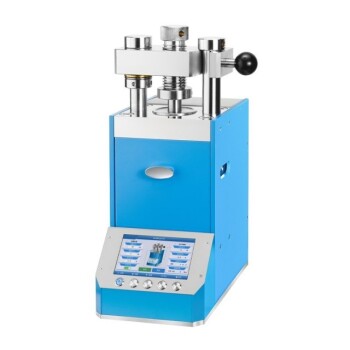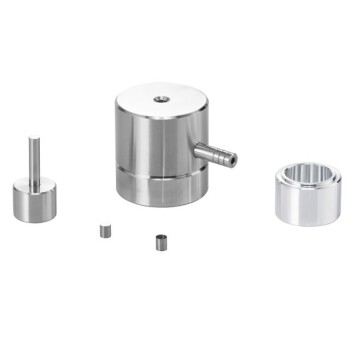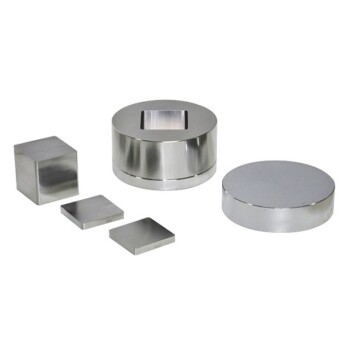In a modern laboratory, the primary use of a hydraulic press is for sample preparation. It is the definitive tool for compressing powdered or pliable materials into solid, uniform pellets or films, which is a critical step for ensuring accurate results in analytical techniques like X-ray fluorescence (XRF) and infrared (IR) spectroscopy. It is also frequently used for material strength testing.
The core function of a laboratory hydraulic press is not merely to crush a sample, but to eliminate analytical uncertainty. By creating a sample with perfect density and surface consistency, the press removes physical variables that would otherwise compromise the accuracy and repeatability of scientific measurements.
The Core Problem: Why Sample Inconsistency Skews Data
To understand the value of a hydraulic press, you must first understand the problem it solves: the inherent inconsistency of raw sample materials.
The Challenge of Raw Materials
Most raw samples, especially powders, are not uniform. They contain air pockets and variations in particle size and packing density.
Analyzing such a sample directly provides a measurement plagued by these inconsistencies, not a true representation of the material's bulk properties.
The Impact on Analytical Accuracy
Techniques like XRF and IR spectroscopy are highly sensitive to the sample's surface. They work by bouncing energy off the material to measure its elemental or chemical composition.
If the surface is uneven or the density is inconsistent, the signal will scatter unpredictably. This creates "matrix effects"—errors where the physical form of the sample, rather than its chemical makeup, distorts the final data.
How a Hydraulic Press Solves the Problem
The hydraulic press systematically removes these physical variables, transforming an unreliable sample into a standardized medium for analysis.
Creating Homogeneous Pellets
A hydraulic press operates on Pascal's Law, using an incompressible fluid to amplify a small initial effort into an immense, evenly distributed force.
This immense pressure forces out air pockets and compacts the material into a solid, non-porous disc with a perfectly flat and uniform surface. This resulting pellet is homogeneous, meaning its properties are consistent throughout.
Ensuring Repeatability
Because the applied force is precisely controlled and measurable, the process is highly repeatable. You can produce identical pellets from different batches of the same material, ensuring that any variations in analytical results are due to genuine chemical differences, not differences in sample preparation.
Applications in Material Testing
Beyond spectroscopy, the precise application of force makes the press essential for materials science. It is used to perform compression tests, determining a material's strength, durability, and failure points under a controlled load.
Key Attributes and Trade-offs
The advantages of a hydraulic press are clear, but understanding the trade-offs between different types is crucial for making an informed decision.
Precision and Force Amplification
The core benefit is the ability to apply thousands of pounds of force with minimal user effort and with a high degree of control. This ensures samples are compacted to their ideal density.
Inherent Safety
Modern lab presses include safety features, such as shields and pressure-release valves, that prevent overloading and protect the operator from the high forces involved.
The Manual vs. Automated Trade-off
The primary trade-off lies between manual and automated presses. A manual press is cost-effective and provides excellent results but requires physical effort and depends on operator consistency.
An automated press offers perfect repeatability and higher throughput at a significantly higher cost, making it ideal for high-volume or highly sensitive quality control environments.
Making the Right Choice for Your Goal
Your choice of press should be dictated by your laboratory's primary objective.
- If your primary focus is achieving the highest analytical accuracy for spectroscopy (XRF/IR): A hydraulic press is essential for creating the consistent, high-quality pellets that minimize analytical errors and ensure data integrity.
- If your primary focus is material property testing: A hydraulic press provides the controlled, high force needed to conduct standardized compression and strength tests according to industry or research protocols.
- If your primary focus is balancing a limited budget with high capability: A manual hydraulic press offers the core benefits of precision and high force, making it a cost-effective workhorse for lower-throughput labs.
Ultimately, the hydraulic press transforms inconsistent materials into a reliable foundation for precise scientific measurement.
Summary Table:
| Key Aspect | Details |
|---|---|
| Primary Use | Sample preparation for compressing materials into uniform pellets or films |
| Key Applications | XRF and IR spectroscopy, material strength testing |
| Core Benefits | Eliminates analytical uncertainty, ensures repeatability, provides precise force control |
| Common Types | Manual (cost-effective) vs. automated (high repeatability) |
Upgrade your lab's precision with KINTEK's hydraulic presses!
Struggling with inconsistent sample data? KINTEK specializes in lab press machines, including automatic lab presses, isostatic presses, and heated lab presses, designed to deliver uniform pellets and reliable results for techniques like XRF and IR spectroscopy. Our solutions enhance accuracy, repeatability, and efficiency in your laboratory workflows.
Contact us today to discuss your needs and discover how our hydraulic presses can transform your sample preparation process. Get in touch now!
Visual Guide

Related Products
- Laboratory Hydraulic Press 2T Lab Pellet Press for KBR FTIR
- Automatic Laboratory Hydraulic Press Lab Pellet Press Machine
- Laboratory Hydraulic Press Lab Pellet Press Button Battery Press
- Manual Heated Hydraulic Lab Press with Integrated Hot Plates Hydraulic Press Machine
- Automatic Laboratory Hydraulic Press for XRF and KBR Pellet Pressing
People Also Ask
- How are hydraulic presses used in spectroscopy and compositional determination? Enhance Accuracy in FTIR and XRF Analysis
- How is a hydraulic press used in sample preparation for spectroscopy? Achieve Accurate and Homogeneous Sample Pellets
- What is the purpose of making KBr pellets in the lab? Achieve High-Sensitivity FTIR Analysis for Accurate Results
- What is the overall significance of hydraulic presses in laboratories? Unlock Precision and Power for Your Research
- What are some laboratory applications of hydraulic presses? Boost Precision in Sample Prep and Testing



















